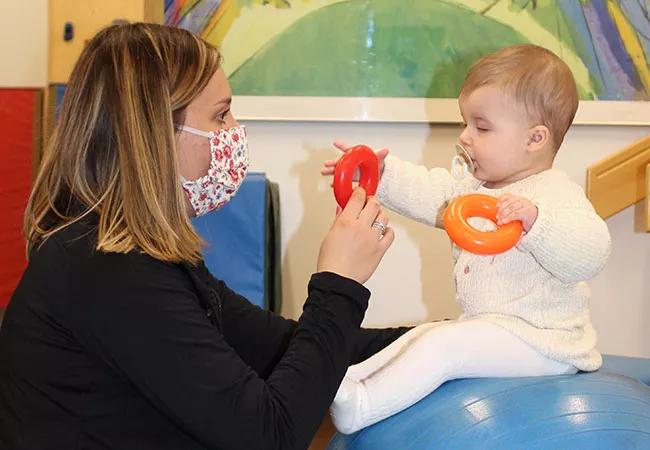A conversation with David Burke, DO

With opioid addiction a public health crisis, non-pharmacologic pain treatments are needed more than ever.
Advertisement
Cleveland Clinic is a non-profit academic medical center. Advertising on our site helps support our mission. We do not endorse non-Cleveland Clinic products or services. Policy
Cleveland Clinic’s Children’s offers pediatric patients a variety of alternative treatments for pain, such as acupuncture and frequency-specific microcurrent (FSM) therapy. Consult QD recently spoke with David Burke, DO, about his use of frequency specific microcurrent (FSM) therapies in the treatment of pain in pediatric patients. Dr. Burke practices general pediatrics and pediatric integrative medicine at Cleveland Clinic Children’s.
What is FSM and how does it work? What is the mechanism of pain relief?
Dr. Burke: FSM is thought to help with pain in two ways: (a) by reducing pain reception and (b) by correcting Ca2+ dysregulation in muscle tissue. The device, which directs a low dose of current into specific tissue types, was approved by the FDA about 25 years ago but originated in the early 1900s. Back then, people didn’t really understand how current worked in the body; however, as we developed electrical stimulation for physical therapy and TENS units, people began to understand how currents could work to stimulate a therapeutic response.
FSM is based on the premise that we are electrical people, and that different currents have different effects on the body depending on how you set them. Measured in hertz, FSM can be used as a complementary therapy for nerve and muscle pain and spasms associated with fibromyalgia, cerebral palsy, spasticity, chronic headaches, post-concussion syndrome, juvenile rheumatoid arthritis, irritable bowel disorder, sprains, strains and a host of other medical issues. We use it quite a bit in Cleveland Clinic Children’s Pediatric Pain Rehabilitation Program as well. Contraindications to FSM include active cancer, dehydration, pregnancy and the presence of a pacemaker or defibrillator.
Advertisement
What results do you see from FSM treatment?
Dr. Burke: We get anecdotal reports that patients feel better and see increased range of motion after FSM. The patients will come back and say “we’re doing things we’ve never done before…” Perhaps they are climbing steps for the first time two days after they saw you when they weren’t making progress before. They may indicate that their pain is considerably reduced, or the pain management people might remark that their use of pain medications is down significantly. However, just like with medications, not all patients will experience such marked pain relief from FSM.
How long is the typical course of treatment?
Dr. Burke: Typical treatments are 20–60 minutes long. Patients with acute injuries may see symptoms improve or resolve in just a few treatments. For children with more chronic illnesses, such as cerebral palsy, we can usually give them relief of symptoms in two to four weeks. Obviously, we can’t cure cerebral palsy, but we can increase patient’s functionality and quality of life.
How is FSM tolerated in children?
Dr. Burke: FSM uses microampere doses of current, which is 1000 times less than the current used in TENS units. For the most part, the currents are not felt by the patient and therefore are very well tolerated. Most of the time, patients do not notice the frequencies and remain fairly relaxed. We try to ensure that pediatric patients, especially younger children, can move about and play during treatment. We may use a wrap — almost like a tennis bracelet — on the head, neck or leg, or we may store the unit in a backpack.
Advertisement
What other alternative pain relief methods do you prescribe to pediatric patients?
Dr. Burke: Our pediatric integrative medicine services have been well-received. We get a lot of referrals from pediatric gastroenterology, rheumatology and neurology, in addition to patients from general pediatrics. I see a lot of patients with breastfeeding problems. Babies can have structural issues from labor and delivery where their temporomandibular joint might be off a little bit, and we can do some gentle manipulative techniques to help with that. I also perform osteopathic manipulations including spine adjustments, myofascial release and other tissue treatments on patients with issues like post-concussion headaches or plagiocephaly.
Advertisement
Advertisement

Large NIH-funded investigation is exploring this understudied phenomenon

Advances in genomics, spinal fluid analysis, wearable-based patient monitoring and more

Case study of radial-to-axillary nerve transfer for tumor-related deltoid nerve injury

An update on the technology from the busiest Gamma Knife center in the Americas

Real-time adjustments may help reduce bothersome dyskinesias

Anatomical modeling can identify optimal surgical candidates, study suggests

Add AI to the list of tools expected to advance care for pain patients

New guidelines from Brain Trauma Foundation urge early and aggressive treatment